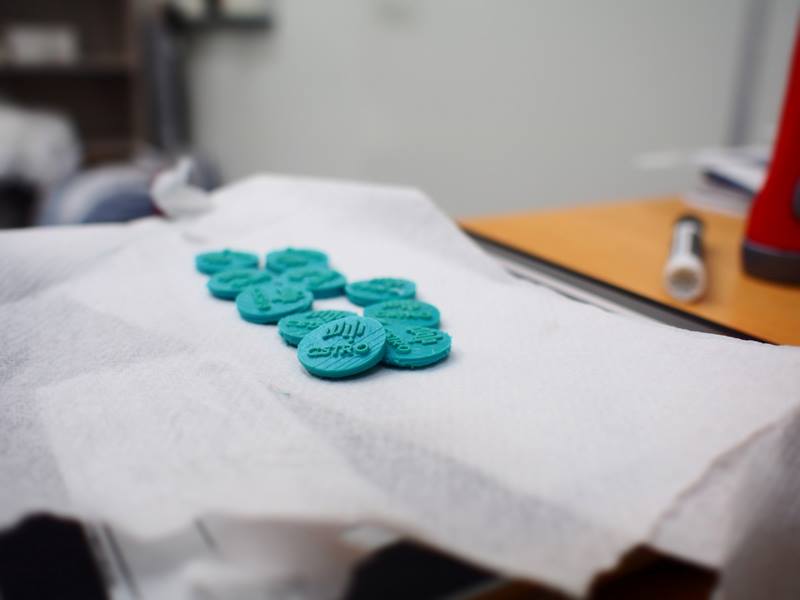Some prototype P-YOM coins that we hope will gain currency.
EDITOR’S NOTE: APRIL FOOLS’!
How many times have you dreamed of having your own personal bank? A money maker in your very own garage, bedroom or kitchen that allowed you to, quite literally, create wealth?
Well, thanks to 3D printing – the same technology that’s brought us horse shoes, bikes, and dragons – those dreams are now one step closer to reality. Our scientists have developed a piece of software that will enable 3D printers to print their own money.
The software program, called P-YOM (Print Your Own Money), will allow consumers with currency in Bitcoin and other online money systems to print coins from their own 3D printers. Once downloaded, P-YOM will integrate with most existing commercial and industrial printers to provide an entirely new source of currency generation.
The development has come about following a partnership we recently entered into with the digital currency industry. The industry are looking to trigger a review of online currency by the Australian Tax Office, which decided last year to classify the online money as a barter system, not a recognised currency.
The digital currency industry works like any other national currency – it can be traded for a range of other national currencies at a fluctuating rate and exchanged for a range of goods and services.
But because it isn’t tied to any national financial system, consumers can make anonymous purchases anywhere in the world, making the movement of the currency hard to track.
Internet money – the way of the future? Image credit: Flickr
“We knew of the great work CSIRO did in inventing waterproof bank notes for Australians, so we hoped they could help us create a water-tight currency,” said Ms Julie Kansas, of the online currency traders Rikers Online Financial Liquidities.
“We think if we can physically put our currency into the hands of a few officials at the ATO, they might change their minds,” Ms Kansas said.
Each coin will be electronically watermarked with an individual “barcode” which will allow it to be tracked via the internet.
Lead scientist on the project, Dr Alex Kingsbury, said the team were already seeing the benefits of the new technology.
“We’ve had a limited test run with P-YOM amongst our staff and they absolutely loved it,” she said.
“Three of them have gone on indefinite leave and we haven’t heard back from them since they last contacted us from the French Riviera.”
“We’re also working with the gaming industry on a 3D printer / poker machine prototype, that could literally create its own winnings. It’s a bit of a gamble currently, but we do hope it will feature heavily once we get it right.”
To purchase either the software or a 3D printer, email socialmedia[at]csiro.au
EDITOR’S NOTE: APRIL FOOLS’!




2nd April 2015 at 9:46 am
Stock exchanges print their imaginary money every day of the year,Profit when markets go up Take the loose change when they go down
Hows that for an APRIL FOOLs Trick 365 Days a Year.
1st April 2015 at 8:56 pm
Stampare i soldi con il computer… non sarà pericoloso? Non mi piace questa cosa.
1st April 2015 at 11:45 am
Great .. Can CSIRO tell me can a 3d printer print a 3d printer?
1st April 2015 at 3:43 pm
Yep. http://reprap.org/
1st April 2015 at 10:36 am
this is ridiculous! did CSIRO even think of what will happen when they did this?
if every 13-year-old basement-dweller can print their own money, then global economics will fail!
what about the poor people who already only have a little bit of money, when digital money becomes real and then there’s is worth nothing!
NOT GOOD!!
1st April 2015 at 12:09 pm
This technology is not about simply printing your own money out of nothing. It is about putting electronic currency (e.g. bitcoin) into a physical form. So if you had bitcoin currency online, you could put that into a physical form which has a barcode on it which is linked to the relevant currency online, it is not creating more currency, as there is only a set amount of bitcoins in the world.
It is not as if people can all of a sudden print their own $2 coins and purchase things with them (though there is nothing stopping someone with their own 3D printer trying!).
This is interesting tech which CSIRO is obviously looking at a variety of ways in which it can be used in the future.
15th April 2015 at 3:41 pm
Have a look at the date of the article – and the acronym for the company “Rikers Online Financial Liquidities” is “ROFL” which is text talk for “Rolling On the Floor Laughing”!
1st April 2015 at 7:40 am
happy Ap 1. 🙂